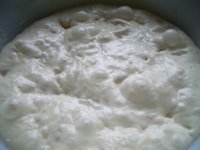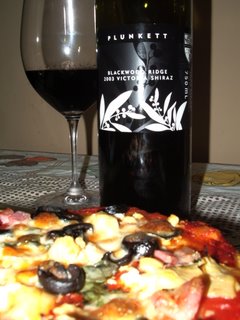fatto a casa

It used to be about take aways. A piping hot, stringy cheese topped, perfect crust masterpiece from a family run shop where the shop itself might have only been the width of the pizza oven. Nowadays the large pizza chains are churning out greasy, vile representations of the humble pie.
Having shifted about several times over the past few years, it is difficult to maintain local status with, let alone find, a decent pizzeria. And since staying in and cooking yields a better result for everything else.. why should pizza be any different?
So I make it at home.
How? Well, in a pinch I admit to using a purchased dough. Most bakeries will part with a bit of their fresh bread dough, sometimes sold by weight, for crust purposes. For those times when pizza cravings hit and even the most tempting delicacy will not suffice in its stead.
But mostly, the need for pizza is premeditated. The mixing, the kneading and the aroma of the dough proofing atop the cupboard.. it is easy, albeit minorly time consuming and the results: undeniably worth every minute.
 Starting a dough is easy enough. I will use a traditional dry yeast for convenience (which works well enough) but if your neighbourhood has a local bakery, they will often have fresh yeast cakes available. I prefer fresh because it dissolves easier, gives a more vigorous rise and, in my opinion, aids in giving a better textured crumb. The crust texture is hugely dependent on the flour and its gluten forming protein content. I save my '00' durum wheat (semolina) flours for pasta and use a stronger unbleached all-purpose flour for pizza dough.
Starting a dough is easy enough. I will use a traditional dry yeast for convenience (which works well enough) but if your neighbourhood has a local bakery, they will often have fresh yeast cakes available. I prefer fresh because it dissolves easier, gives a more vigorous rise and, in my opinion, aids in giving a better textured crumb. The crust texture is hugely dependent on the flour and its gluten forming protein content. I save my '00' durum wheat (semolina) flours for pasta and use a stronger unbleached all-purpose flour for pizza dough.A quick tomato sauce is easy to prepare using a small jar of homemade sauce simmered for a few flavour infusing minutes over garlic and onion sauteed in olive oil finished with a sprinkle of oregano. It shouldn't be too watery but not reduced to a paste consistency, and a thin covering is all you need.
Although the chunky topped (unbaked) pizza in the picture doesn't look too sparse, the lighter the load the better the end product. For family, I keep it as they like it. Simple. Two or three toppings at the most with the exception of quattro formaggi. Here we were emptying the fridge: a sprinkle of black olives, a few bits of artichoke hearts, one slice of pancetta (diced), a few capers, some sliced pickled chilles and torn basil dotted with rough pieces of scamorza. Ah, cheese.
Scamorza is a mild, stretched curd cheese traditionally ripened but for a few days that has that typical stringy melt. It is what most commercial 'mozzarella' cheeses really are. I won't turn this post into the great Mozzarella debate, but the only cheese that can be called 'mozzarella' is mozzarella di bufala. Made with buffalo milk, it is so delicate and gloriously flavoured that placing it over pizza should be a crime. It is, however, acceptable (and more economical) to use the alternative versions made with cows milk to top a pizza margherita. Commonly called bocconcini (the little bites) and larger 'fior di latte' slice much easier and won't release whey on baking to make your beautiful crust a soggy mess.
 Baking pizza should have but one rule. And that is the oven should be hot hot hot. I set the gas to a blistering 230 degrees C, preheat a terracotta baking stone and shift the pizzas in and out of the oven on parchment paper (not waxed paper) with a wooden board. This heat sets the exterior of the crust quickly so that it doesn't get the chance to rise in the oven. Here is where the crispy thin crust with the chewy interior is formed. Baking stones are now readily available in good supply shops and a good one will last indefinitely.
Baking pizza should have but one rule. And that is the oven should be hot hot hot. I set the gas to a blistering 230 degrees C, preheat a terracotta baking stone and shift the pizzas in and out of the oven on parchment paper (not waxed paper) with a wooden board. This heat sets the exterior of the crust quickly so that it doesn't get the chance to rise in the oven. Here is where the crispy thin crust with the chewy interior is formed. Baking stones are now readily available in good supply shops and a good one will last indefinitely.I cannot say the same of the pizza. We celebrated the World Cup with a triple batch of dough, that is 12 individual pizze about 25 cm diameter or so and a group of friends. And a bottle of Plunkett's Shiraz


Comments